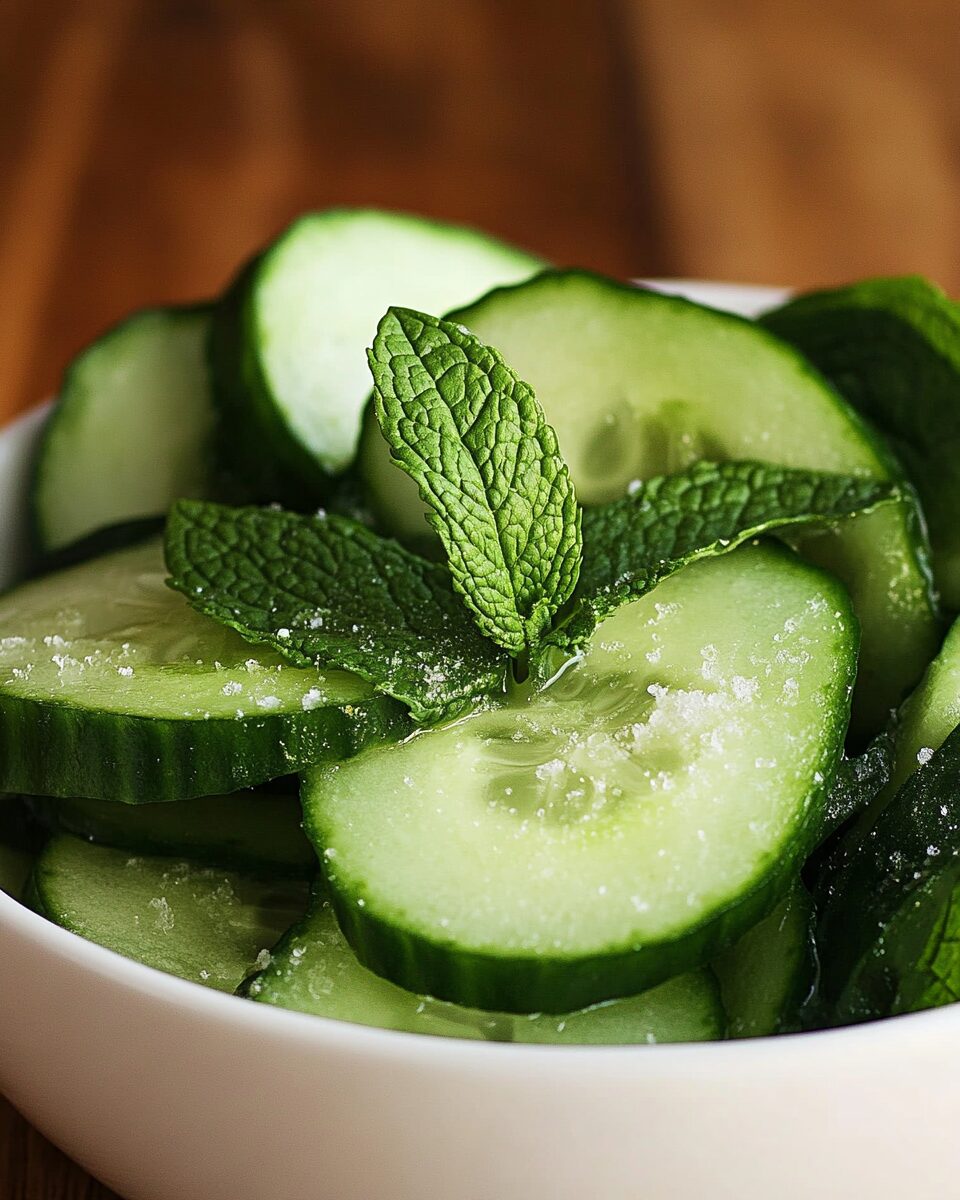Moroccan Cucumber Mint Salad is a light and vibrant dish perfect for hot weather or as a zesty complement to heavier mains. This salad blends the cooling crunch of thin-sliced cucumbers with the bright tang of white wine vinegar and a hint of sweetness, all balanced by aromatic mint. It’s a classic staple on Moroccan tables, especially served alongside a variety of small salads before the main meal.
Whether you’re looking to enhance your Mediterranean menu or simply searching for a quick and healthy side, this recipe delivers. It’s naturally vegan, low in calories, and made with pantry staples—no fancy equipment required. Make it ahead and chill for a crisp bite that’s full of flavor, ideal for picnics, BBQs, or weekday dinners.
Full recipe:
Ingredients:
-
2 cucumbers, sliced thin
-
¼ teaspoon salt
-
3 tablespoons white wine vinegar
-
2 tablespoons olive oil
-
1 teaspoon sugar
-
¼ teaspoon black pepper
-
2 tablespoons fresh mint, roughly chopped
Directions:
-
Slice cucumbers lengthwise, then into thin slices. Place in a small bowl and sprinkle with salt. Let sit for 20–30 minutes.
-
Transfer the salted cucumbers into a colander and allow the excess liquid to drain. Pat dry with paper towels.
-
In a separate bowl, whisk together white wine vinegar, olive oil, sugar, salt, and black pepper. Adjust seasoning to taste.
-
Toss the drained cucumber slices in the dressing. Add chopped mint and stir to combine.
-
Garnish with an extra sprig of mint before serving.
Prep Time: 10 minutes | Additional Time: 20 minutes | Total Time: 30 minutes
Kcal: 82 kcal | Servings: 4 servings
The Role of Salads in Moroccan Cuisine
Unlike in many Western cuisines, salads in Morocco are not just an afterthought or a side dish. They are an essential part of the meal and often served before the main course as a display of abundance and generosity. When you sit down for a traditional Moroccan meal, especially during lunch, it’s common to be greeted with a vibrant array of small salads known collectively as salades marocaines. These can include a variety of seasonal vegetables—carrots, beets, tomatoes, potatoes, and, of course, cucumbers.
These salads are not smothered in creamy dressings or overwhelmed by cheese. Instead, they let the ingredients shine with a simple treatment: fresh herbs, olive oil, lemon or vinegar, and salt. They’re designed to be light, flavorful, and refreshing—setting the tone for the rich and spiced dishes that follow.
The Star Ingredients: Cucumber and Mint
Cucumber and mint may seem like a familiar pairing to many, but in Moroccan cuisine, they come together with exceptional harmony. Cucumber, with its high water content and crisp texture, is the ideal base for a salad designed to cool and refresh. It’s particularly welcome in Morocco’s hot climate, where rehydrating foods are highly valued, especially during summer months or the holy month of Ramadan.
Mint, on the other hand, is practically the national herb of Morocco. It features in countless dishes and is also the key ingredient in the beloved Moroccan mint tea, which is more of a cultural experience than just a beverage. The mint used in the cucumber salad brings a fresh, clean flavor that not only enhances the cucumber’s mild taste but also elevates the entire dish.
A Balancing Act: The Dressing
What truly transforms this cucumber salad into a Moroccan classic is the dressing. Rather than heavy dressings, Moroccan salads typically feature simple vinaigrettes made with vinegar or lemon juice, olive oil, salt, and sometimes a touch of sugar. The result is a light, tangy coating that brings brightness and depth to the dish without masking its main components.
In this particular salad, white wine vinegar is paired with olive oil and a bit of sugar to balance the acidity. A dash of black pepper adds subtle heat, rounding out the profile and enhancing the natural flavors of the cucumber and mint. This balance between acidity, sweetness, and richness from the oil is what makes Moroccan salads so memorable.
Cultural and Nutritional Significance
From a cultural standpoint, this salad is a perfect example of Moroccan hospitality—simple yet thoughtful, fresh yet full of character. It’s an expression of how Moroccan food honors vegetables and herbs as key components of the meal, rather than relegating them to the background.
Nutritionally, the salad is a powerhouse of hydration and health. Cucumbers are low in calories but high in important vitamins and antioxidants. They support hydration, aid in digestion, and have anti-inflammatory properties. Mint, too, is not only flavorful but also known to promote digestion, soothe headaches, and freshen breath. Olive oil provides heart-healthy monounsaturated fats, while the light use of vinegar supports metabolic health and adds a probiotic punch when fermented.
This makes the dish ideal for a wide range of dietary lifestyles: vegan, gluten-free, paleo, and low-calorie diets all welcome it with open arms.
When to Serve It
One of the best things about Moroccan cucumber mint salad is its versatility. It can be served as a refreshing appetizer or as a side dish accompanying roasted meats, grilled fish, or hearty stews. It’s a particularly great pairing with dishes that have bold spices or rich sauces, as the salad cuts through heaviness and resets the palate.
It’s also an excellent choice for warm-weather meals, picnics, or BBQs. The coolness of the cucumber and the brightness of the mint provide a contrast to the charred, smoky flavors of grilled foods. It’s quick to prepare and can be made ahead of time, making it a smart option for entertaining or busy weeknights.
When serving it in a traditional Moroccan meal, it’s typically presented in small bowls alongside other vegetable salads like carrot salad with oranges and cumin, beet salad with lemon, or tomato and green pepper shlada. The presentation itself becomes a celebration of color and freshness.
Tips for the Best Moroccan Cucumber Salad
-
Use Fresh, Firm Cucumbers: Whether you choose English cucumbers, Persian, or garden-fresh varieties, make sure they are crisp and unblemished for the best texture.
-
Salt and Drain: Letting the cucumbers sit with salt helps draw out excess moisture. This step prevents the salad from becoming watery and intensifies the cucumber flavor.
-
Add Mint Last: If making the salad ahead of time, wait to add the mint just before serving. This keeps it bright, aromatic, and prevents it from turning dark or soggy.
-
Chill Before Serving: For maximum refreshment, serve this salad chilled. It’s particularly invigorating when cold, especially during hot days.
Modern Variations and Adaptations
While the traditional version is delightful on its own, there’s room to experiment. Some modern twists include adding:
-
A squeeze of lemon juice for extra zing
-
Crumbled feta or goat cheese for a salty bite
-
Pomegranate seeds for sweetness and color
-
Chopped red onion for extra crunch
-
Toasted almonds or pine nuts for added texture
These variations can help adapt the dish to different cuisines or flavor profiles while retaining its essential identity.
Conclusion
The Moroccan cucumber mint salad is a celebration of simplicity, balance, and flavor. It takes humble ingredients and turns them into a refreshing and culturally rich dish that’s as nutritious as it is delicious. Whether served as part of a traditional Moroccan spread or as a cooling side dish to your favorite grilled entree, it never fails to add brightness to the table.
Its ease of preparation, adaptability to different diets, and ability to elevate any meal make it a recipe worth keeping in your culinary repertoire. Beyond its refreshing taste, it invites you into the world of Moroccan food culture—where every dish, no matter how simple, tells a story of tradition, hospitality, and love of good food.






